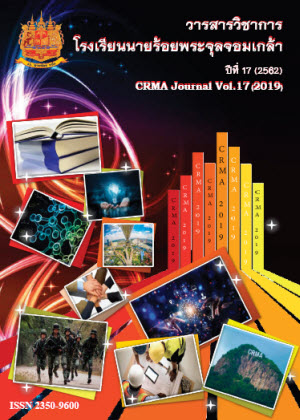Research and Development of Concrete Ditch Mixed with Rubber Latex for Farm Irrigation System
Main Article Content
Abstract
Research and development of concrete ditch mixed with rubber latex farm irrigation system. This study analyzed the physical and mechanical properties of concrete mixed with rubber latex (pre-vulcanized). The experiment was performed in a laboratory to test the properties of the mixture in terms of microstructure, workability, compressive strength, tensile strength, flexural strength and water absorption of concrete. To test the performance polymer and cement (P/C) were mixed in different proportions of 0%, 1%, 3%, 5%, 10% and 15% by weight to prepare the solution and was further added to concrete and the strength of the structure was tested after 28 days. The results indicated that the polymer cement ratio (P/C) of 1% gives the best performance with 244 ksc compressive strength, 35 ksc tensile strength, 46 ksc flexural strength and 1% water absorption of concrete. Thus, this study recommends that polymer cement ratio (P/C) of 1% by weight is most suitable for construction of concrete ditches. The material used in construction of irrigation ditch was consist of Portland cement 50 kg, sand 135 kg, gravel 148 kg, water 29.67 kg and rubber latex 0.83 kg. For field research precast concrete lining ditch having the bottom width of 0.4 m, height 0.3 m and thickness 0.07 m were constructed using the recommended mixture. The preliminary evaluation of the ditches in the field also indicates that these ditches allow water to flow quickly and easily. Reduction in the seepage loss the irrigation efficiency has improved significantly.
Article Details
Copyright of all articles published is owned by CRMA Journal.
References
พีรวัฒน์ ปลาเงิน (2558). รายงานวิจัยฉบับสมบูรณ์ การประยุกต์ใช้น้ำยางพาราและดินซีเมนต์พัฒนาสระน้ำต้านภัยแล้ง. สำนักงานคณะกรรมการวิจัยแห่งชาติ (วช.) และสำนักงานกองทุนสนับสนุนการวิจัย (สกว.)
พีรวัฒน์ ปลาเงิน, ชวน จันทวาลาย์, สมพร พิบูลย์ และฐกลพัศ เจนจิวัฒนกุล (2559). การถ่ายทอดเทคโนโลยีประยุกต์ใช้น้ำยางพาราในงานบำรุงรักษาระบบชลประทาน. วารสารวิชาการโรงเรียนนายร้อยพระจุลจอมเกล้า, ปีที่ 14, ฉบับที่ 14, หน้า 117 - 129
พีรวัฒน์ ปลาเงิน (2549). รายงานวิจัยฉบับสมบูรณ์ การศึกษาการรั่วซึมของน้ำในแบบจำลองคลองชลประทานผสมน้ำยางพารา. โครงการวิจัยแห่งชาติ : ยางพารา, สำนักงานคณะกรรมการวิจัยแห่งชาติ (สกว.)
พีรวัฒน์ ปลาเงิน และชวน จันทวาลย์ (2559). รายงานการวิจัยและการพัฒนาวิจัยการเกษตรฉบับสมบูรณ์ การพัฒนาคลองชลประทานผสมน้ำยางพาราสำหรับใช้ในระบบชลประทานไร่นา สำนักงานพัฒนาการวิจัยการเกษตร (องค์การมหาชน) : สวก.
พีรวัฒน์ ปลาเงิน, ชวน จันทวาลาย์, สมพร พิบูลย์ และฐกลพัศ เจนจิวัฒนกุล (2559). รายงานกิจกรรมส่งเสริมและสนับสนุนการวิจัย การถ่ายทอดเทคโนโลยีประยุกต์ใช้น้ำยางพาราในงานบำรุงรักษาระบบชลประทาน. สำนักงานคณะกรรมการวิจัยแห่งชาติ
Chatveera, B. and Wongkamjan, W. (2001). “Mechanical Behavior of Fine RHA Concrete,” KMUTT Research and Development Journal, 24 (3), pp. 327-342.
Chatveera, B. and Kongsub, T. (2002) “Durability of Concrete Containing Black RHA from Rice Mill,” KMUTT Research and Development Journal, 25 (4), pp. 374-389.
Homsriprasert, W.and Chatveera, B. (2016) “Mechanical Properties of Fly Ash-based Geopolymer Mortar with Electric Oven Curing under Sodium Sulfate and Magnesium Sulfate Attacks,” KMUTT Research and Development Journal, 39 (2), pp. 271-286.
Phoo-ngernkham, T., Hanjitsuwan, S. and Chindaprasirt, P. (2016). “Influence of Sand to Binder Ratio on Properties of Geopolymer Mortar Containing Portland Cement,” KMUTT Research and Development Journal, 39 (2), pp. 127-137.
วราภรณ์ ขจรไชยกุล (2554) เอกสารประกอบการบรรยาย โครงการถ่ายทอดความรู้วิชาการพื้นฐานด้านยางพาราสำหรับนักวิจัยเพื่อพัฒนาข้อเสนอโครงการวิจัยยางพารา. สำนักงานกองทุนสนับสนุนการวิจัย 3 – 6 สิงหาคม 2554
American Society for Testing and Materials (2009) ASTM C33 Standard Specification for Concrete Aggregates, ASTM International, Book of Standards, Volume 04-02, West Conshohocken, PA.
วราภรณ์ ขจรไชยกุล (2549) ยางธรรมชาติ : การผลิตและการใช้งาน สำนักงานกองทุนสนับสนุนการวิจัย พิมพ์ครั้งที่ 1 สิงหาคม 2554
American Society for Testing and Materials (2009) ASTM C143 Standard Test Method for Slump of Hydraulic-Cement Concrete. Annual Book of ASTM Standard, Section 4 Construction, Volume 04.02 Concrete and Aggregate.
American Society for Testing and Materials (2009) ASTM C39 Standard Test Method for Compressive Strength of Cylindrical Concrete Specimens, Annual Book of ASTM Standard, Section 4 Construction, Volume 04.02 Concrete and Aggregate.
American Society for Testing and Materials (2009) ASTM C496 Standard Test Method for Splitting Tensile Strength of Cylindrical Concrete Specimens, Annual Book of ASTM Standard, Section 4 Construction, Volume 04.02 Concrete and Aggregate.
American Society for Testing and Materials (2009) ASTM C78 Standard Test Method for Flexural Strength of Concrete (Using Simple Beam with Third-Point Loading), Annual Book of ASTM Standard, Section 4 Construction, Volume 04.02 Concrete and Aggregate.
American Society for Testing and Materials (2009) ASTM C234 Standard Test Method for Comparing Concretes on the Basis of the Bond Developed with Reinforcing Steel, Annual Book of ASTM Standard, Section 4 Construction, Volume 04.02 Concrete and Aggregate.
American Society for Testing and Materials, 2009, ASTM C1585 Standard Test Method for Measurement of Rate of Absorption of Water by Hydraulic-Cement Concretes, Annual Book of ASTM Standard, Section 4 Construction, Volume 04.02 Concrete and Aggregate.
เนาวรัตน์ ป้อมเพชร (2526). หลักเกณฑ์การออกแบบระบบชลประทานในแปลงนา. เทคโนโลยีที่เหมาะสมในการทำงานชลประทาน. กรมชลประทาน, กรุงเทพมหานคร.

